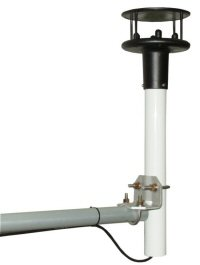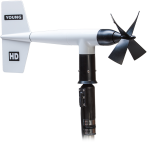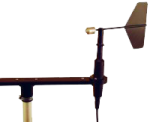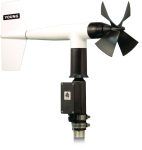
Minimizes routine maintenance costs






概览
WindSonic1是一款二维超声波风速计,用于测量风向和风速。它为传统的机械杯和叶片或螺旋桨和叶片风速计提供了一种替代方案。传感器输出RS-232信号,可由当前的Campbell Scientific数据采集器直接读取。
不建议在出现霜、冰或水平雪的情况下使用Windsonic1。该传感器无加热功能。请联系Campbell Scientific,了解在这些条件下工作的具备加热功能二维声波风速计的信息。
注:随此传感器提供的安装设备可能因传感器订购的Campbell Scientific地区办事处而异。
优势与特点
- Low maintenance—no moving parts significantly reduces maintenance cost and time
- Provides a minimum detectable wind speed of 0.01 meters per second
- Compatible with the SDM-SIO1A, which increases the number of sensors one data logger can measure
图像

技术说明
The WindSonic1 uses two pairs of orthogonally oriented transducers to sense the horizontal wind. The transducers bounce the ultrasonic signal from a hood, thus minimizing the effects of transducer shadowing and flow distortion.
Unlike mechanical anemometers, the WindSonic1 has no moving parts to be periodically replaced—minimizing routine maintenance costs.
Four WindSonic1 anemometers can be connected to a single CR1000, CR3000, CR300, CR310, CR6, or CR1000X datalogger. Two WindSonic1 anemometers can be connected to a single CR800 or CR850 datalogger.
产品规格
| Applications |
|
| Sensor | 2-dimensional ultrasonic anemometer |
| Measurement Description | Wind speed and direction |
| Input Voltage | 9 to 30 Vdc |
| Typical Current Drain | ~15 mA (continuous) |
| Operating Humidity Range | < 5% to 100% RH |
| Operating Temperature Range | -35° to +70°C |
| Storage Temperature Range | -40° to +80°C |
| Measurement Frequency | 40 Hz block averaged to a 1 Hz output frequency |
| Outputs Parameters | Polar (direction and speed) or orthogonal (Ux and Uy wind) |
| Output Signal | RS-232 |
| Maximum Cable Capacitance | 2500 pF |
| Maximum Cable Length |
15.24 m (50 ft) For configurations requiring longer cable lengths, consider using the WindSonic4-L 2-D Sonic Wind Sensor with SDI-12 Output instead, or contact Campbell Scientific for other options. |
| Diameter | 14.2 cm (5.6 in.) |
| Length | 16.0 cm (16.3 in.) |
| Weight | 0.5 kg (1.1 lb) |
Wind Direction |
|
| Range | 0º to 359° (no dead band) |
| Accuracy | ±3° |
| Resolution | 1° |
Wind Speed |
|
| Range | 0 to 60 m/s |
| Accuracy | ±2% (@ 12 m s-1) |
| Resolution | 0.01 m/s |
兼容性
Please note: The following shows notable compatibility information. It is not a comprehensive list of all compatible products.
测量与控制
| Product | Compatible | Note |
|---|---|---|
| SDM-SIO1A |
Additional Compatibility Information
Mounting
The WindSonic1 is shipped with the 17387 mounting kit. This mounting kit is used to attach the sensor to a CM202, CM204, or CM206 crossarm. The crossarm is then mounted to a tripod or tower.
下载
WindSonic1 Example Programs v.1 (2 kB) 12-02-2020
Two example CR1000X programs that read the WindSonic1. One program reads the sensor directly, and the other program uses an SDM-SIO1A/SDM-SIO4A. Both programs filter out data when the status code is not 0. The programs also report the number of good samples that were used in computing the online statistics.
常见问题解答
WINDSONIC1: 6
展开全部收起全部
-
All WindSonics (option 1 or option 4) are shipped from Campbell Scientific with an interface cable. If the cable has been lost, order a replacement. Order model WINDSONIC1CBL-Lxx for an option 1 or WINDSONIC4CBL-Lxx for an option 4, where xx is the cable length. The maximum cable length is 50 feet for option 1. The maximum cable on the SDI-1 bus is 200 feet.
-
Yes, as long as these two conditions are met:
- There are no obstructions in the measurement volume.
- The temperature is between -35 to +70 degrees Celsius.
-
There are no user-serviceable parts on the WindSonic1 and WindSonic4. Should the WindSonic require service, it will start setting diagnostic flags. Campbell Scientific recommends that all data logger programs record the total number of times the flags are set in an output period. For details, see the WindSonic Instruction Manual.
-
The fastest output frequency is 4 Hz for the WindSonic1 and 1 Hz for the WindSonic4.
-
The WindSonic is not suitable for measuring the vertical wind component. The WindSonic measures the wind that passes through its measurement volume. It does not care what the orientation is. If the WindSonic is turned on its side, the reflecting top and body of the sensor will cause massive flow distortion of the wind vector, specifically for the horizontal component that is perpendicular to the reflective top. This flow distortion will most likely result in erroneous vertical wind measurements.
-
The fundamental measurement frequency of the WindSonic is 40 Hz (40 measurements per second). These measurements are then averaged to give an output at some slower output frequency. For a WindSonic programmed to produce 1 Hz data, all 40 measurements are averaged. (This is called a block average.) For a WindSonic that is programmed to produce 4 Hz data, each output is the block average of 10 fundamental measurements.
案例研究
Overview In the heart of the UAE’s Empty Quarter desert—one of the harshest and least hospitable......阅读更多
Overview The Kingdom of eSwatini in Southern Africa—with its agricultural-based economy and a population of less......阅读更多












